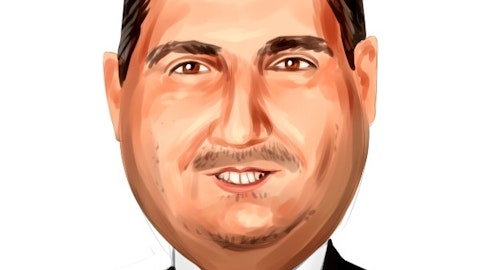Gates Schwarzmann: Thank you. Yes, I have one follow-up. I would like to ask if it’s possible to walk through the offerings get an idea of non-discretionary revenue in the base versus what clients can push out, asking this because as we see the sequential track record lately, some of the items we thought were safer like cloud and IT has stepped down while some that we thought were more prone to cost cutting like analytics and applications have done better than expected. Thank you.
Mike Salvino: So look, what I would tell you is we’ll break the two of your question into the 2 pieces, GBS and GIS. So, on GBS, we see our GBS business continuing to grow, but at a lower rate due to A&E, we believe, is in a tough market. We think Michael has done a nice job selling application or analytics and engineering onto our GIS customers. But we are seeing that slow a little bit. I don’t think that’s any new news to anybody. Applications have continued to be flat. And with the addition to Howard, we think he can definitely improve on that. But right now, we’re keeping it flat. And then the final thing is, we’ve been pretty bullish around insurance. just in terms of what Ray is doing in the market and so forth. So we continue to see growth there.
If you then turn the page to GIS, we think that basically, the GIS business we’ll maintain what it’s doing today. Both Chris with ITO and Andrew are very focused on positioning both of those businesses for future success, and I gave you some details around what Chris is doing with ITO. So I would highlight those two things again, he’s working with Rob to take our underutilized assets, the facilities and put them, make sure that we can sell them because the longer we hang on to them, the less value that they have, all right? So we’re pushing hard to make sure that happens this year. The second thing is AWS, and we’re pretty happy about that to say the least. I say that because for years now, we have not gotten our fair share of the cloud business.
And with AWS, with us being that partner of choice, that clearly puts us into the cloud migration and the cloud operations business like I said, traditionally, we have not participated as well as we wanted to. When you look at the cloud industry right now, what we see is they’re focused on the essential systems that run customer operations and that’s our ITO business. And when somebody like AWS gives you that partner of choice credential, that’s a big deal. And what they see is they see a firm like us that has great customer relationships that are trusted because this essential stuff is not easy to run, and they also know that we can make the migration work successfully. And the tidbit I’ll give you is, we’re expecting AWS, when I say they’ll incentivize us and work with us, they’re going to train roughly 15,000 of our women and men on AWS to make that happen.
So that’s quite a bit of scale. So that’s what we see. Hopefully, that gives you what you need.
Operator: Your next question comes from the line of James Friedman with Susquehanna. James, go ahead.
James Friedman: So you’ve had some impressive accomplishments, especially the free cash flow and the free cash flow per share. And I was wondering if you could kind of unpack how you’re achieving that, Rob, because it really stands out on both the numerator and denominator.
Rob Del Bene: Yes. There are several as you would imagine, there are several factors that contribute to the free cash flow performance. It starts with the value delivered by the teams and the offerings that we have, the profitability of those offerings. Another big contributor is a significant cost reduction activities that the teams have embarked on. And last year, they were very successful in achieving the cost reduction goals. This year, we’re on track with our cost reduction goals, and that will continue. The third area of emphasis has been on management of capital outlays and management of longer-term commitments like leases. And we are very focused on in that on both and we’ve been successful in steadily driving the commitments down over time.



